HyperX’s Alloy keyboards have been regulars on pretty much all of our pro player gear lists. With a no-nonsense and portable design along with a sturdy frame and no-frills approach to extra features it’s not a big surprise that professional players like these boards so much, and today we’re taking a look at whether or not you could like them too.
The HyperX Alloy Origins Core has been out for a while now and builds upon what made its predecessors so popular while trying to up the ante by including HyperX’s very own key switches. Is this board worth all the hype or is it flawed to the core? Read our full review to find out.
At A Glance
HyperX Alloy Origins Core
Used by 24 players ()It doesn’t rock the world but it’s definitely one of the better ‘no BS’ gaming TKL boards out there at this point in time.
Pros
- Nice switches
- Built like a tank
Cons
- Keycaps are subpar
Specs
| Form Factor | TKL |
|---|---|
| Switches | HyperX Aqua, HyperX Red |
| PCB | Non-Hotswappable |
| RGB | Yes |
| Height | 3.4cm |
| Width | 36.1cm |
| Length | 13.2cm |
| Weight | 845g |
First Impressions
Quick note before I begin: I got both the Aqua and Red version of this keyboard to test out. Both are exactly the same apart from the switches so what I say in this review goes for both boards. I will talk about both switches and how they perform and feel in this review.
The HyperX Alloy Origins Core (there’s also the full sized Alloy Origins) is a board that’s beautiful in its simplicity. Contrary to what a lot of boards aimed at the gaming market do this is not a product that tries to reel you in with fancy features or nifty dials and knobs: this one is all business. Whether you like that or not is of course entirely subjective but as someone who isn’t into giant boards this one gets a nod of approval from me.
The only noticeable logo on the case comes in the form of a blacked out ‘HyperX’ above the arrow keys but aside from that this Alloy Origins Core looks sleek and subtle. It’s heavy, too: this one is all aluminum, making for a board that’s perhaps heavier than you’d expect from a mass produced gaming keyboard, but that (to me) makes it feel more premium and sturdy so that’s a win in my book.
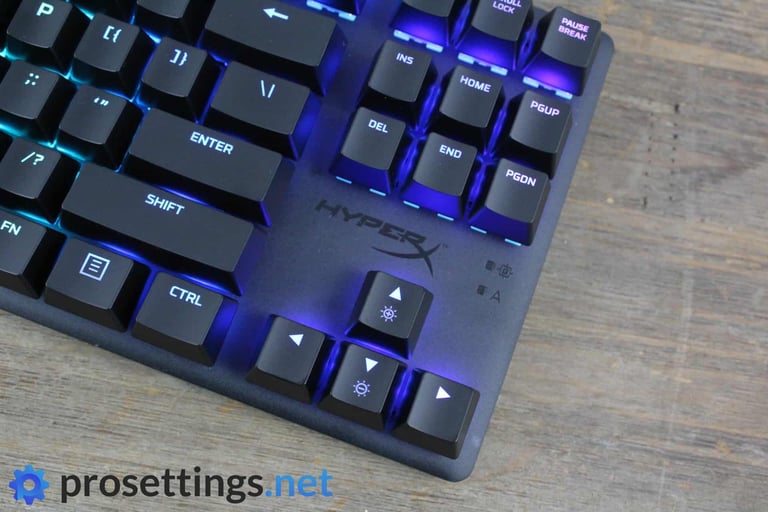
The RGB is done well too: it’s bright and vivid, and at the higher brightness levels there’s a faded reflection on the top plate of the board giving the whole appearance an extra touch. If you care about this sort of thing you’re good to go here.
What’s slightly weird here is the location of the cable. It might be a coincidence, but every keyboard that I’ve ever tested or used has had the cable situated either on the left side or in the middle, and here it’s on the right. I don’t mind that at all but I did find myself occasionally wondering where the hole was when I switched between the two different versions of this board during testing. Again: this doesn’t matter at all to me but I did notice it right away so it belongs in the first impressions part.
Packaging
As an esports board the Alloy Origins Core doesn’t come with a lot of extras. Inside the box you get the board, the detachable USB-C cable, and a quickstart guide along with a warranty card. I don’t have a need for any stickers or anything like that so I’m fine with the rather barebones unboxing experience, doubly so because this keyboard isn’t exactly priced in the premium tier of boards.
I do always appreciate the addition of a keycap puller (I find it to be an essential piece of kit to maintain your board, even if you’re not going to be switching out caps) so perhaps that’s something they can consider for the future but aside from that you of course have everything you need to get started in the box.
Features and Build
As a board that’s made for competitive gaming this is a TKL design, meaning that they basically cut off the numpad portion of the keyboard. That gives you more room for your mouse to move around, and seeing that high level/pro players generally play at a low sensitivity this extra space won’t go unused.
As mentioned there’s also a full size version of this keyboard available but what I’d like to see is a 65% version. This form factor is becoming more and more popular and is, for me, the ultimate compromise between features and a smaller footprint. That’s neither here nor there though since we’re talking about this board, so back to that.
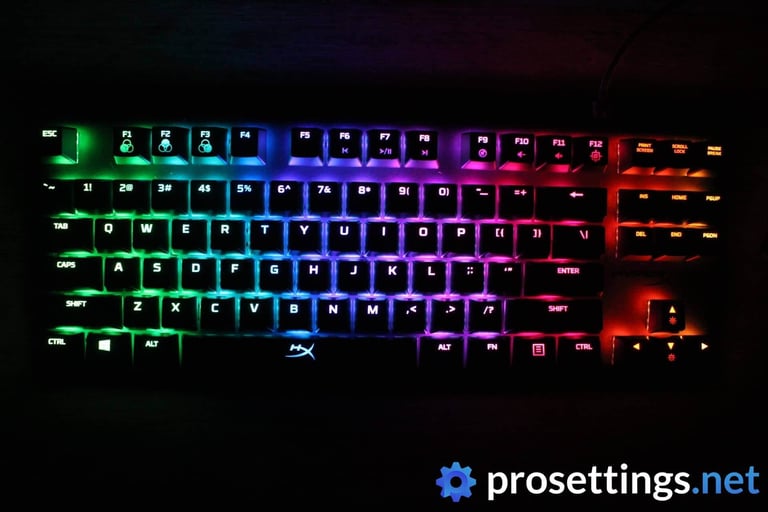
Take a gander at the pics that accompany this review and you’ll notice that this board is relatively stripped down. There are two indicator LEDs on the right side of the board: one for caps lock and another for gaming mode but that’s pretty much it in the ‘extra features department’. That’s of course more than fine since this board just isn’t made for that but if you’re someone who wants a bunch of dedicated media keys (you can access basic media functions by using certain button combos though) or dials you’re better off skipping this.
I mentioned it earlier: the case of the Alloy Origins Core feels very well built and high quality so it’s a bit of a bummer that the keycaps don’t follow suit. These ABS keycaps are pretty decent as far as ABS caps go but I’d always rather have a PBT set, for example. I didn’t actually mind using these for my testing period since the font is okay (the letters are a bit large and blocky but that’s probably done to make the RGB shine through better) and the caps don’t feel all too flimsy or cheap but of course these are gonna develop a shine after a while and they don’t do a very good job at handling oils and sweat.
If you’re someone who’s not all that sensitive to these things you’re more than likely going to be just fine with how these caps feel but in case you’re not you’ll be glad to learn that this board has a completely standard layout so it will fit a lot of aftermarket keycap sets.
On the bottom of the keyboard there are four rubber feet to keep it in place and they do a perfect job at that. The grippy feet in combination with the weight make for a rock solid board that stays put under even the most extreme gaming circumstances. It’s still easy enough to adjust by giving it a horizontal push near the bottom, which is something that I like since I often move my keyboard a tiny bit during gaming sessions.
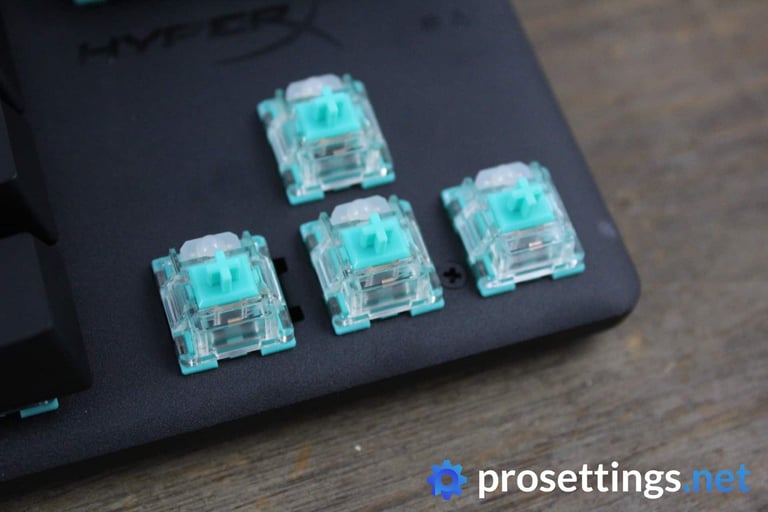
The two-step adjustable feet allow you to put the board at a total of three different angles, with the highest angle being at 11 degrees. That’s pretty steep so the adjustability here should please most people. The feet also have rubber elements on the bottom so you don’t lose any stability if you opt for the angled experience.
All in all this keyboard is pretty much the perfect ‘no nonsense’ gaming board in my opinion: it’s sturdy, compact, and has a floating switch design. It’s a bit of shame that the keycaps are rather average but these are easily swapped out if they bother you.
Performance and Everyday Usage
The most obvious changes between this and the earlier Alloy FPS boards are the inclusion of RGB and the fact that these Origins boards come with HyperX’s very own switches. The Core version can be had with either Red or Aqua switches while the full size edition has the added option of Blues. Those who know their way around keyboard components will not be surprised by the fact that the Red switches are linear (just like the ‘OG’ Cherry MX Reds) but Aqua is of course not a Cherry switch so that might raise a couple of question marks that I’ll dissipate right away: the Aquas are based on Cherry MX Browns.
These HyperX switches have an actuation point of 1.8mm and a total travel distance of 3.8mm. That makes them a bit faster than the Cherries they’re based on, but only marginally. In fact I didn’t quite notice the difference in ‘speed’ between the HyperX switches and their Cherry MX siblings, but that’s not important since these switches aren’t built for speed and no one is claiming that they’re lightning fast or anything; HyperX state that they’re ‘elegantly balanced for responsiveness and accuracy.’
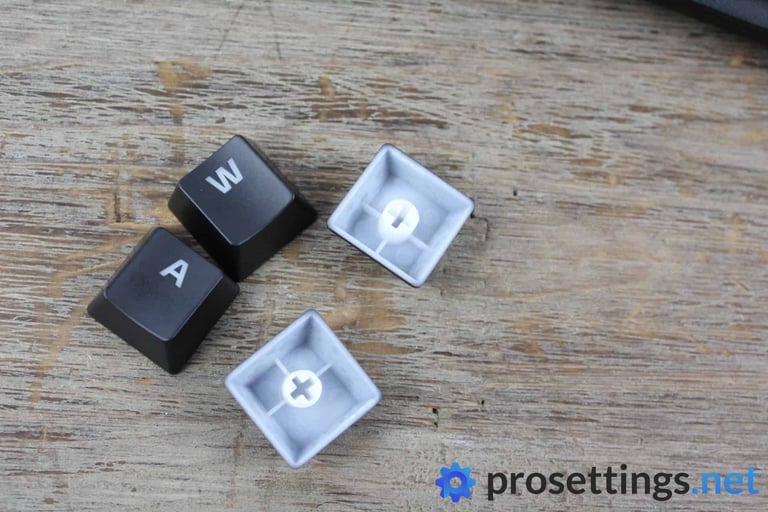
I’ve got to say that I really like these switches. I first tested the Aquas (because Cherry MX Browns used to be my go-to switches in the past) and was very pleasantly surprised. They’re a bit on the loud side but they’re smooth and have a nice actuation on top of being just about the right amount of stiffness for me personally. What I noticed is that these are quite a bit less ‘scratchy’ than Cherry MX Browns, which makes me prefer the Aquas over those if I had to choose.
The Reds feel great too: I don’t feel as much of a difference here to make me outright prefer them over Cherry Reds but they do have that same smoothness and nicely balanced stiffness that I felt with the Aquas. These are some really nice linear switches.
The stabilizers on the board are okay: I do hear some rattling here and there but overall they’re decent. Unless you’re picky about this and have lots of experience with high tier boards you’re probably not going to be annoyed by this at all, so the overall typing and gaming experience that you get is very, very solid here. HyperX have really done a nice job with these switches.
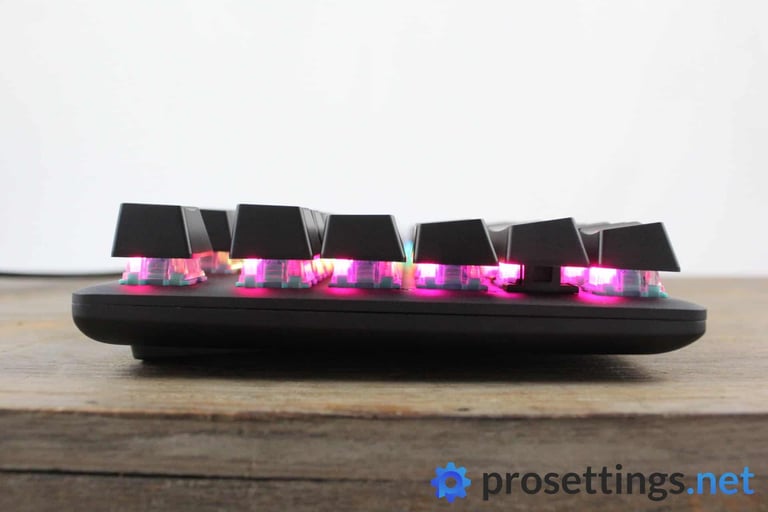
There’s room for up to three saved profiles on the board, and these can be configured in HyperX’s NGENUITY software, which is available as a Windows app. I’m not a big fan of the fact that it’s an app but I do have to say that the software does what it has to do. It allows you to create macros, reassign buttons, and tweak the RGB lighting, so it’s all there but it’s not the prettiest or most expansive piece of software that I’ve ever used and I for some reason don’t really like the fact that it has to be downloaded from the Windows store. The board works perfectly fine without the software installed though so if you don’t want to mess around with all of that then you don’t really have to.
Sound Tests
HyperX Red
HyperX Aqua
HyperX Alloy Origins Core Review – Conclusion
This is the first time I’ve spent any real amount of time with the HyperX Alloy and it really did not disappoint. If you’re looking for a portable no-nonsense TKL board with great switches (I prefer the Aquas over Cherry MX Browns, and the HyperX Reds feel as good as Cherries to me) that’s built like a rock this does deserve a spot at the top of your list.
There are some things they can improve on (namely the key caps and the fact that the software is a little barebones and is a Windows Store app, though that last one is a personal grievance) but the Alloy Origins Core delivers on all fronts that it has to deliver on to make it one of the better dedicated esports keyboards. I just wish they’d also make these in a 65% form factor.
It doesn’t rock the world but it’s definitely one of the better ‘no BS’ gaming TKL boards out there at this point in time.
This product was received for free from the manufacturer and given to our reviewer to test and review. Brands and manufacturers have no editorial control over our reviews. For more information, check out our review FAQ.


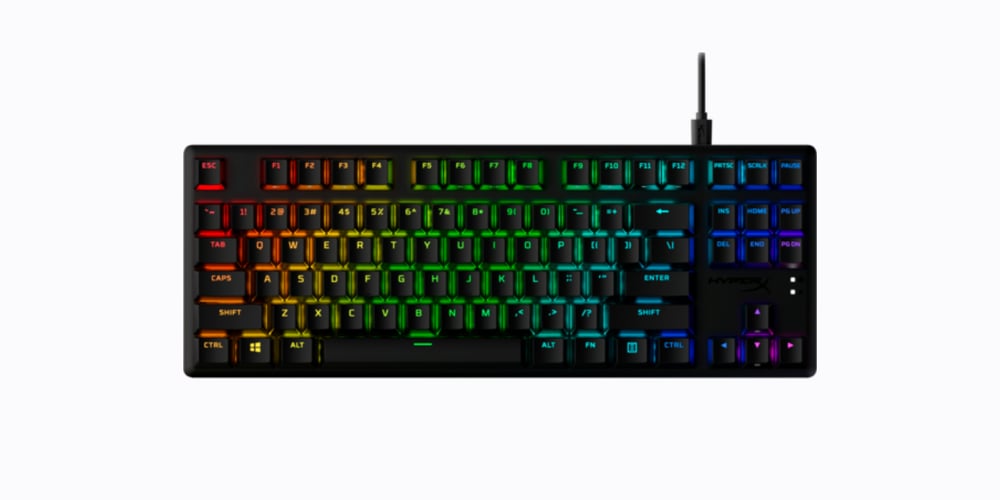





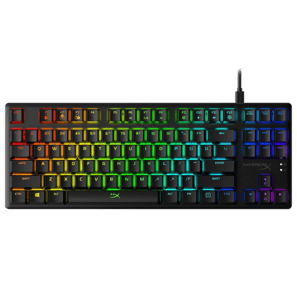


Fun fact this keyboard is known as the cheater keyboard in osu because most top players use it
i would like to say hyperx alloy orgins core with hyper x red switch or the gk61 with yellow switches btw i am playing fortnite
I haven’t tested the GK61 so I can’t really say a lot about it, sorry! The Alloy Origins Core is definitely a fantastic keyboard though, I can vouch for that one.
What’s the best value competitive keyboard for FPS/Moba that has good build quality? I’ve always used the Razer Blackwidow Ultimate 2016 edition but the stabilizers on the spacebar and enter key are cheap and break easily and now I am looking at this one.
The Alloy line is actually one of the better ‘bang for your buck’ esports boards I’ve tried over the past couple of months. Of course none of these production boards really match custom made keyboards with high end stabilizers and switches (but those are way more expensive) but as far as production boards go I’d say the Alloy line is a great buy if you’re looking for a reliable keyboard without any flashy features that drive up the price. I also rather like their switches.